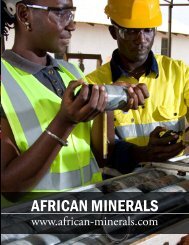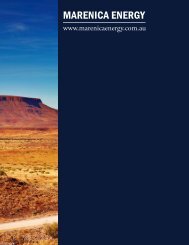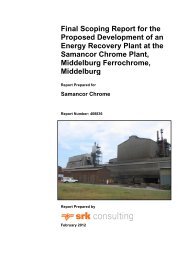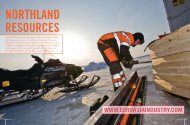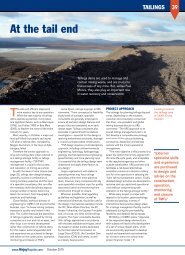Draft Status Quo Report for the Pixley Ka Seme ... - SRK Consulting
Draft Status Quo Report for the Pixley Ka Seme ... - SRK Consulting
Draft Status Quo Report for the Pixley Ka Seme ... - SRK Consulting
You also want an ePaper? Increase the reach of your titles
YUMPU automatically turns print PDFs into web optimized ePapers that Google loves.
<strong>SRK</strong> <strong>Consulting</strong> in association with BKS<br />
<strong>Pixley</strong> <strong>Ka</strong> <strong>Seme</strong> Local Municipality EMF – <strong>Draft</strong> <strong>Status</strong> <strong>Quo</strong> <strong>Report</strong> Page 49<br />
Coal mining involves <strong>the</strong> extraction of a non-renewable<br />
resource and benefits need to be compared with<br />
industries such as agriculture, <strong>for</strong>estry and tourism that<br />
involve renewable resource uses (Van Zyl, 2010).<br />
3.6.5 Forestry<br />
The <strong>for</strong>estry industry in PKSLM is small compared to<br />
GSDM as a whole and consists of plantations covering<br />
roughly 1,077 ha (or 0.21% of <strong>the</strong> total PKSLM land<br />
area). It is probable that roughly 25 to 40 direct jobs are<br />
supported by <strong>the</strong> sector based on provincial averages <strong>for</strong><br />
employment per ha of plantation.<br />
Demand <strong>for</strong> timber is unlikely to increase beyond<br />
normal growth levels. Water availability and <strong>the</strong><br />
availability of suitable land play are fur<strong>the</strong>r factors<br />
limiting expansion potential. In particular, <strong>the</strong> majority<br />
of <strong>the</strong> study area coincides with areas of stress or water<br />
deficit (DWAF 2004, 2004a and 2004b).<br />
3.6.6 Economic values associated with<br />
<strong>the</strong> maintenance of natural capital<br />
The high value of properly functioning ecosystems<br />
particularly in terms of water services provides an<br />
economic justification <strong>for</strong> <strong>the</strong>ir protection and<br />
restoration. PKSLM boasts grasslands that are generally<br />
in significantly better condition than those in <strong>the</strong><br />
Maloti-Drakensberg and care needs to be taken to avoid<br />
degradation. Improvements can be made in pockets of<br />
land that have become degraded.<br />
One of <strong>the</strong> key regulating ecosystem services provided<br />
by grasslands are associated with <strong>the</strong> water environment<br />
given <strong>the</strong> areas importance at <strong>the</strong> headwater of three<br />
major catchments/WMAs. Numerous wetlands are<br />
present in <strong>the</strong> area including <strong>the</strong> Wakkerstroom wetland<br />
which is of national prominence (Palmer, 2010). The<br />
Wakkerstroom wetland complex is one of few peatland<br />
wetlands in South Africa. They are centres of<br />
biodiversity, act as carbon sinks and are key to <strong>the</strong><br />
hydrological functioning of drainage systems (PKSLM,<br />
2008). The services provide water security <strong>for</strong> <strong>the</strong> area<br />
and also play a critical role as a ‘water factory’ area<br />
with national importance <strong>for</strong> water security (Van Zyl,<br />
2010).<br />
Thus far <strong>the</strong> waste sink function and o<strong>the</strong>r regulating<br />
functions of <strong>the</strong> aquatic and terrestrial environment<br />
appears to be working relatively well in most parts of<br />
PKSLM. Future planning and management will have to<br />
be exercised with care if ecological infrastructure in <strong>the</strong><br />
study area is to keep delivering. Intensively developed<br />
catchments nearby such as <strong>the</strong> Olifants River provide<br />
lessons regarding to <strong>the</strong> economic risks associated with<br />
<strong>the</strong> degradation of <strong>the</strong> water environment and natural<br />
capital (Van Zyl, 2010).<br />
3.6.7 Economic costs/externalities<br />
associated with resource uses<br />
Key resources uses (agriculture, tourism and recreation,<br />
mining, <strong>for</strong>estry and harvesting) have <strong>the</strong> potential to<br />
clash with each o<strong>the</strong>r and destroy/degrade natural<br />
capital or ecological infrastructure from terrestrial and<br />
aquatic natural areas.<br />
Mining primarily impacts on water quantity and quality,<br />
land degradation, air quality and biodiversity. It fur<strong>the</strong>r<br />
and exacerbates impacts through high volumes of truck<br />
traffic. Water pollution may impact downstream of <strong>the</strong><br />
pollution source with potential international<br />
implications.<br />
The available evidence and observation of <strong>the</strong> situation<br />
in o<strong>the</strong>r mining areas indicates a high risk of significant<br />
unmitigated cumulative impacts from intensive mining.<br />
Despite numerous EIAs and seemingly well funded<br />
Environmental Management Plans, significant damage<br />
is occurring in mining areas. Potentially unacceptable<br />
residual impacts appear to be a reality of coal mining,<br />
particularly where a number of mines operate in<br />
sensitive areas. Adequate mitigation does not equate<br />
with observable reality at this point and strongly<br />
suggests that <strong>the</strong> precautionary principle needs to be<br />
applied to <strong>the</strong> approval of mining in <strong>the</strong> first instance in<br />
sensitive areas (Van Zyl, 2010).<br />
The often parlous state of roads in Mpumalanga can act<br />
as a significant constraint to tourism development in<br />
remote areas such as PKSLM reliant on road access.<br />
Forestry has a marked impact on <strong>the</strong> natural<br />
environment and affects biodiversity, water and soil<br />
resources as well as air quality. Extensive <strong>for</strong>estry also<br />
has <strong>the</strong> ability to reduce available water substantially. In<br />
<strong>the</strong> Usutu River, <strong>for</strong> example, it is estimated that<br />
70 000 ha of pine plantations reduce water yield by<br />
about 50%. In addition, elevated sediment loads and<br />
pollution can be detrimental to water quality and <strong>the</strong><br />
availability of aquatic habitats.<br />
KILI/BEAT G:\404946_PIXLEY EMF\7REPORTS\<strong>Status</strong> <strong>Quo</strong> report\<strong>Draft</strong> report\<strong>Draft</strong> status quo report, July 2010.docx July 2010




